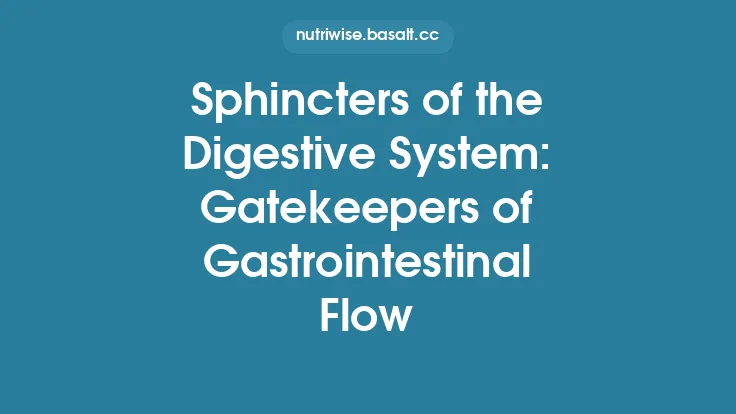The enteric nervous system (ENS) is often called the “second brain” of the body because it can operate independently of the central nervous system (CNS) while still maintaining constant communication with it. Embedded within the wall of the gastrointestinal (GI) tract, the ENS orchestrates the complex patterns of muscle contraction, secretion, and blood flow that are essential for moving luminal contents and for sensing the chemical and mechanical environment inside the gut. Its ability to generate reflexes locally makes it a pivotal regulator of motility, ensuring that peristaltic waves, segmental mixing, and sphincter coordination occur in a seamless, self‑sustaining manner.
Anatomical Overview of the Enteric Nervous System
The ENS is a vast network of neurons, glial cells, and supporting structures that extends longitudinally along the entire length of the GI tract, from the proximal esophagus to the distal colon. Unlike the CNS, which is protected by the skull and vertebral column, the ENS resides within the layers of the gut wall itself, primarily between the circular and longitudinal smooth‑muscle layers (the muscularis externa) and just beneath the mucosa (the submucosa). This strategic placement allows the ENS to directly monitor and influence both muscular activity and mucosal function.
Key anatomical features include:
- Neuronal cell bodies clustered in two major plexuses (discussed in detail below).
- Enteric glial cells, which provide metabolic support, modulate synaptic transmission, and maintain the integrity of the gut barrier.
- Interneurons and motor neurons that form intricate circuits capable of generating rhythmic motor patterns without external input.
- Sensory endings that detect stretch, tension, and chemical composition of the luminal contents.
Collectively, these components form a semi‑autonomous circuitry capable of rapid, localized decision‑making.
Neuronal Types and Organization
The ENS contains an estimated 200–600 million neurons, a number comparable to that of the spinal cord. These neurons are classified based on function, morphology, and neurochemical phenotype:
| Functional Class | Primary Role | Typical Neurotransmitters |
|---|---|---|
| Sensory (afferent) neurons | Detect mechanical stretch, chemical stimuli, and mucosal irritation | Substance P, calcitonin‑gene‑related peptide (CGRP) |
| Interneurons | Relay information between sensory and motor neurons; integrate multiple inputs | Acetylcholine (ACh), nitric oxide (NO), vasoactive intestinal peptide (VIP) |
| Motor (efferent) neurons | Directly innervate smooth muscle, secretory cells, and blood vessels | ACh (excitatory), NO & VIP (inhibitory) |
Morphologically, neurons can be multipolar, bipolar, or unipolar, and they often exhibit extensive dendritic arborizations that facilitate synaptic integration. The presence of both excitatory and inhibitory motor neurons enables the ENS to fine‑tune muscle tone and generate coordinated waves of contraction and relaxation.
Primary Plexuses: Myenteric and Submucosal
Two distinct ganglionated plexuses dominate the ENS architecture:
- Myenteric (Auerbach’s) Plexus
- Location: Between the longitudinal and circular muscle layers.
- Primary Functions: Regulation of gut motility, including peristalsis, segmentation, and sphincter control.
- Key Neuronal Populations: A high density of motor neurons (both excitatory and inhibitory) and interneurons that form the core circuitry for generating rhythmic motor patterns.
- Submucosal (Meissner’s) Plexus
- Location: Within the submucosa, just beneath the mucosal epithelium.
- Primary Functions: Modulation of local blood flow, secretion, and absorption; integration of sensory information from the mucosa.
- Key Neuronal Populations: Predominantly sensory neurons and interneurons that convey information about luminal composition to the myenteric plexus.
The two plexuses communicate via short‑range interneuronal pathways, allowing motility patterns to be adjusted in response to changes in luminal content, pH, osmolarity, and mechanical load.
Neurotransmitters and Receptors
The ENS employs a rich palette of neurotransmitters, each acting on specific receptor subtypes to produce excitatory or inhibitory effects:
- Acetylcholine (ACh): Binds to muscarinic (M₁–M₅) receptors on smooth muscle, causing contraction. It also stimulates secretory cells.
- Nitric Oxide (NO): A gaseous messenger that diffuses into smooth‑muscle cells, activating guanylate cyclase and leading to relaxation.
- Vasoactive Intestinal Peptide (VIP): Works synergistically with NO to promote smooth‑muscle relaxation and increase mucosal blood flow.
- Substance P and Neurokinin A: Bind to neurokinin receptors (NK₁, NK₂) to enhance excitatory motor activity and promote inflammation when over‑released.
- Serotonin (5‑HT): Primarily released by enterochromaffin cells; acts on 5‑HT₃ and 5‑HT₄ receptors to modulate sensory signaling and peristaltic reflexes.
The balance between excitatory (ACh, Substance P) and inhibitory (NO, VIP) transmitters is crucial for the generation of coordinated motility patterns. Dysregulation of this balance underlies many functional GI disorders.
Intrinsic Reflex Circuits
The ENS is capable of generating several stereotyped reflexes that control motility without CNS input. The most fundamental is the peristaltic reflex, which can be broken down into three sequential steps:
- Sensory Detection: Stretch receptors in the circular muscle detect distension caused by a bolus.
- Interneuronal Integration: Afferent signals ascend within the myenteric plexus, activating excitatory interneurons oral to the stimulus and inhibitory interneurons anal to it.
- Motor Execution: Excitatory motor neurons contract the circular muscle oral to the bolus, propelling it forward, while inhibitory motor neurons relax the circular muscle anal to the bolus, allowing the lumen to expand.
Other intrinsic reflexes include:
- Segmental Mixing Reflex: Alternating contraction of circular muscle segments creates a “churning” motion that enhances mixing and exposure of luminal contents to the mucosa.
- Migrating Motor Complex (MMC): A cyclic, fasting‑state motility pattern that sweeps residual debris from the small intestine. Although the MMC is coordinated by both ENS and CNS inputs, its basic rhythm originates from intrinsic pacemaker activity within the myenteric plexus.
These reflexes illustrate how the ENS integrates sensory input, processes it through interneuronal networks, and produces precise motor outputs.
Coordination of Smooth Muscle Activity
Smooth muscle in the gut wall exhibits two primary orientations:
- Circular muscle: Constriction narrows the lumen, generating propulsion.
- Longitudinal muscle: Shortening shortens the segment, aiding in bolus movement.
The ENS synchronizes these layers through dual‑phase motor patterns:
- Phase I (Contraction): Excitatory motor neurons release ACh onto circular muscle, causing a localized contraction that pushes the bolus forward.
- Phase II (Relaxation): Simultaneously, inhibitory motor neurons release NO and VIP onto the longitudinal muscle, allowing it to shorten and pull the segment ahead of the bolus.
The timing of these phases is finely tuned by interneuronal circuits that adjust the duration and intensity of each neurotransmitter release based on real‑time feedback from stretch receptors and mucosal chemoreceptors.
Interaction with the Central Nervous System
Although the ENS can function autonomously, it maintains bidirectional communication with the CNS via the vagus nerve (parasympathetic) and spinal afferents (sympathetic). This gut‑brain axis serves several purposes:
- Top‑down modulation: CNS signals can alter ENS excitability, for example, during stress when sympathetic activation suppresses motility.
- Bottom‑up signaling: Sensory information from the ENS travels to the brainstem and higher cortical centers, influencing appetite, nausea, and emotional states.
Neuroimmune pathways also intersect with the ENS; cytokines released during inflammation can modify neuronal firing patterns, linking immune status to motility changes.
Clinical Relevance and Disorders
Understanding ENS fundamentals is essential for diagnosing and treating a range of functional and motility disorders:
- Irritable Bowel Syndrome (IBS): Altered ENS sensitivity and dysregulated neurotransmitter release (e.g., heightened 5‑HT signaling) contribute to abnormal motility and visceral pain.
- Chronic Intestinal Pseudo‑Obstruction: Loss or dysfunction of myenteric neurons leads to ineffective peristalsis, mimicking mechanical obstruction without a physical blockage.
- Hirschsprung’s Disease: Congenital absence of enteric ganglion cells in distal colon results in tonic contraction and functional obstruction.
- Diabetic Autonomic Neuropathy: Hyperglycemia‑induced damage to ENS neurons reduces NO production, impairing inhibitory pathways and causing dysmotility.
Therapeutic strategies often target ENS neurotransmission—e.g., 5‑HT₄ agonists to enhance motility, or NO donors to promote relaxation—highlighting the clinical importance of ENS pharmacology.
Research Frontiers and Emerging Technologies
The ENS remains a vibrant field of investigation, with several cutting‑edge approaches reshaping our understanding:
- Single‑cell RNA sequencing: Reveals distinct neuronal subpopulations and novel neuropeptides, offering potential biomarkers for disease.
- Optogenetics and chemogenetics: Enable precise activation or inhibition of specific ENS circuits in animal models, elucidating causal relationships between neuronal activity and motility patterns.
- Enteric organoids: Stem‑cell‑derived mini‑gut systems that recapitulate ENS‑gut interactions, providing platforms for drug screening and disease modeling.
- Neuro‑imaging advances: High‑resolution functional MRI and positron emission tomography (PET) are beginning to visualize ENS activity in vivo, bridging the gap between animal studies and human physiology.
These innovations promise to translate basic ENS knowledge into targeted therapies for motility disorders and to deepen our appreciation of the gut’s autonomous capabilities.
Summary
The enteric nervous system is a sophisticated, self‑contained neural network that governs the rhythmic and coordinated movements essential for gastrointestinal function. By integrating sensory inputs, processing them through intricate interneuronal circuits, and delivering balanced excitatory and inhibitory signals to smooth muscle, the ENS orchestrates peristalsis, segmentation, and sphincter control. Its dual plexus organization, diverse neurotransmitter repertoire, and capacity for intrinsic reflexes underscore its autonomy, while its communication with the central nervous system ensures that gut activity remains responsive to the body’s broader physiological state. Mastery of ENS fundamentals not only enriches our understanding of digestive physiology but also provides a foundation for addressing the myriad motility disorders that affect millions worldwide.





